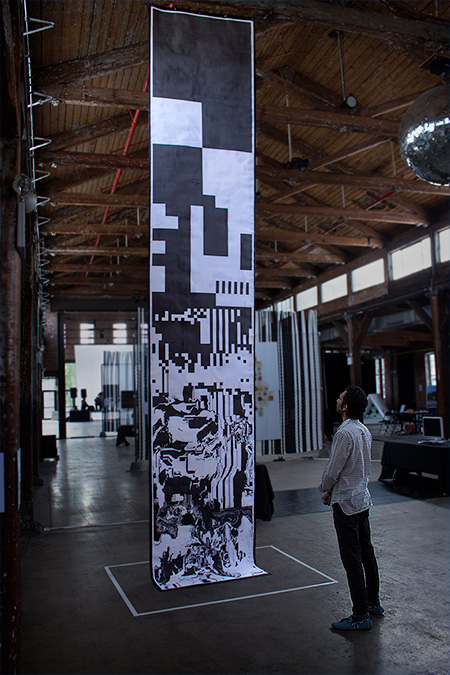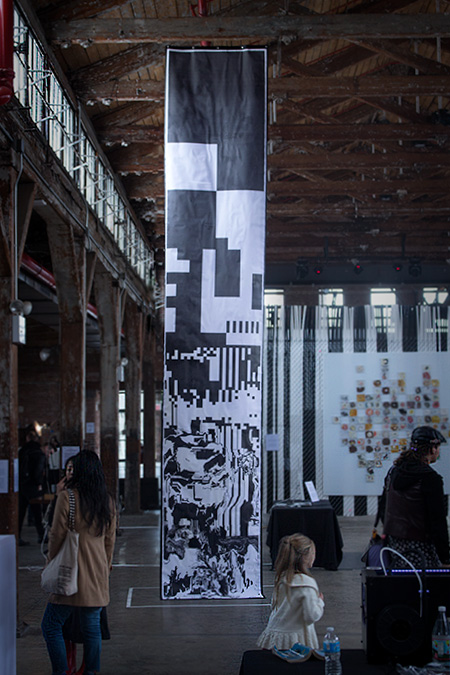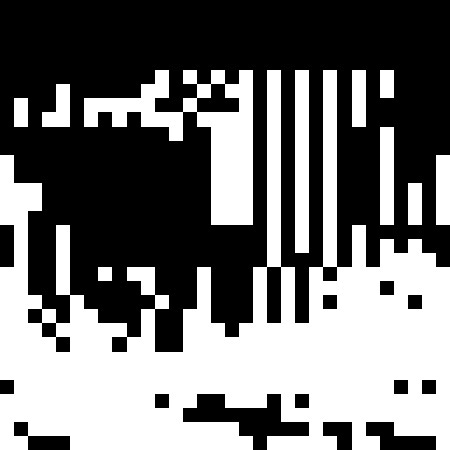blake marques carrington
discography:




 vimeo highlights:
vimeo highlights:



 contact
bio
contact
bio





blake marques carrington
discography:




 vimeo highlights:
vimeo highlights:



 contact
bio
contact
bio







Digital pigment print on cotton, Gaffer Tape, 20ft x 40in
036 The End of Information
The End of Information is an inkjet painting generated by sound – a recording of a psychoanalysis session between the artist and a therapist. Using a custom software system of the artist's design, the audio waveform of the session is used as a material for digital drawing. The different parts of the work explore the spectrum from low-resolution graphic information bit to high-resolution subjective image space. The work is site-specific, with dimensions varying according to height of the exhibition space. It is meant to hang freely as a tapestry from the ceiling, with the bottom of the piece just barely touching and curling up on the floor.
This work fits into my overall concept of “Speculative Forensics”, which takes inspiration from sources in physics, psychology, computer science, and popular culture.
The “Speculative Forensics” concept borrows its central question from a debate in contemporary physics – can information be lost? Theoretical physicists and science writers call this the “Black Hole Information Loss Paradox”, which speculates on whether a bit of information going into a black hole is destroyed when the black hole shrinks to nothing, or whether it somehow escapes in an encoded form as the black hole evaporates. Physicist Leonard Susskind, a member of the latter group that believes the information escapes, proposed a clever analogy that I find striking. Called “The Bathtub Option”, he invites us to 'imagine drops of ink falling into a tub of water, carrying a message — drip, drip, drop, drip, drop, space, drop, drip. Soon the sharply defined drops begin to dissolve, the message gets harder to read, and the water becomes cloudy. After a few hours, all that’s left is a uniform tub of slightly gray water. […] Soon the fluid starts to evaporate from the tub. Molecule after molecule escapes into empty space — ink as well as water — eventually leaving the tub dry and empty.' The information has not been destroyed, just encoded in a configuration too complex for humans to read.
Taking this concept into the realm of psychology, the information bit going into the black hole can be read as a bit in our subconscious. In everyday life as the expression of latent content, and through the practice of psychoanalysis and triggering the subconscious through use of the Rorshach Inkblot Test, that hidden information emerges from the subconscious in encoded form. In the case of my work, the visual pixel, after being generated from sound, passes through turbulence and an array of forces. I wonder whether the translation (in linguistic, formal, geometric terms) of that pixel could be reversed so that it reconstitutes the audio waveform it came from, and could that audio waveform be translated back into the spoken word, and could that spoken word really point to some hidden quality in the subconscious?
In computer science, the field of digital forensics attempts similar feats with encoded and encrypted data. When a user deletes a file on her computer, it still exists in unallocated space on the hard drive. The process of deleting merely removes the file from the consciousness of the graphical user interface. Like psychoanalysts, digital forensics specialists have ways to pry that hidden information free. And like the bathtub option described above, the bits of information of a single file may be distributed throughout the physical surface of a hard drive disk, like molecules floating in the air.
Lastly, “Speculative Forensics” draws inspiration from the common trope in film and TV, particularly cop shows like CSI: Crime Scene Investigators, where an image can be “enhanced” in order to reveal previously hidden information. The trope is also shown famously in the films “Blow Up” by Michaelangelo Antonioni, “Blade Runner” by Ridley Scott, and as audio recording in “Blow Out” by Brian de Palma. In The End of Information, I use this reference in displaying the visual content at varying resolutions. Touching the floor is an image of very high resolution, which requires very close viewing. As the work extends toward the ceiling, the resolution shrinks exponentially, 512 pixels by 512 pixels, 8 by 8, 2 by 2, and finally, a single black pixel. The leap from single black square to subjective image space is laid bare, admitting to the fiction of all digital representations.



Prior to the Creative Tech Week exhibition, The End of Information was published as an image/text piece by the journal of digital imaging and photography In the In-Between, edited by Gregory Eddi Jones. Also it was performed as a slideshow lecture for the panel discussion The End at Pratt Upload 2016, organized by Everett Kane and also featuring critic Jennifer Krasinski, curator Rachel Steinberg, and artist Tommy Hartung.
053 Study on Reflections (Delayed But Not Forgotten)
052 Black Box Drawings
051 Create New Formations (Facade version)
050 Study on the Metaphysical Status of a Table
049 An Infinite Density Over Zero
048 Computational Landscape Series
047 Seismoglyph (Mitosis version)
046 Artbook Trilogy
045 Plasmatic FK
044 Bonsai-Gan
043 The Albers Variations
042 A Mess That Encodes
041 An Extended Bootleg
040 A Scattered Bootleg
039 TYWMC at FILE Festival São Paulo
038 TYWMC at Mapbox Locate
037 An Infinite Distance Between Two Points
036 The End of Information
035 Patti Smith Italy Tour
034 Strata Systems v02_NIJIMI
033 Killer Road
032 The Year We Make Contact
031 Bessarabia Ghost Tapes
030 Strata Systems v01_LOCI
029 Performance at The Icebox for Shaping a Signal
028 A Strong Hand That Nonetheless Gets You Nowhere
027 Apple Blossom Time
026 Loci_Convergence
025 Noisebed
024 Loci_Palimpsest
023 The Ornithologist Ghosthunter
022 Erosion/Evaporation (Scan Reina Sofia)
020 Haeinsa_Palimpsest
018 High and Low (Sightlines)
017 Dis/continuum
016 Cathedral Scan
015 Suomenlinna Ornithological Society
014 Loci_
012 Topoextension
011 ATS02: Solve
007 ATS01: Wisp
005 Moby the Mobile Projection Unit
004 Avalanche at Broad Street